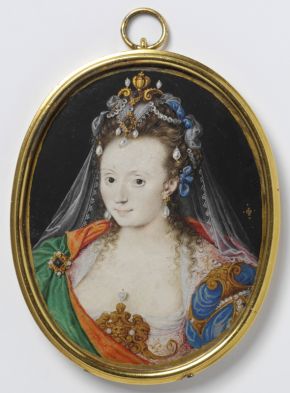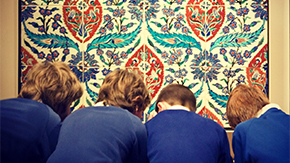Closed Exhibition - Treasures of the Royal Courts: Tudors, Stuarts and the Russian Tsars
Treasures of the Royal Courts: Portrait Miniatures

An Unknown Woman in Masque Costume, Isaac Oliver, England, 1609. Museum no. P.3-1942. © Victoria and Albert Museum, London
Royal portraits
Miniatures of royalty often played a part in marriage negotiations with foreign courts. They also had a domestic political role. Queen Elizabeth’s ambassadors often carried her portrait in miniature, which was much admired. James I understood the power of these tokens of loyalty, and miniatures of the Stuart royal family proliferated. At court miniature portraits of the king were given and worn as a mark of royal favour and the courtier’s loyalty. When James’s daughter, also Elizabeth, was exiled from Bohemia, miniatures served to broadcast her plight around Europe.
Public or private?
Miniatures were not only private tokens. ‘Cabinet’ miniature's would have been shown in a display case or hung in a small room (both called cabinets) along with other precious objects. The portrait above of a lady in masque costume was probably set in a locket. The court masques were a form of symbolic theatre in which James I’s queen, Anne of Denmark, and her ladies often took part. This sitter therefore publicly proclaims herself one of the queen’s intimate circle.
Intimate portraits
Miniatures were above all likenesses of beloved faces, even if framed by formal ruffs or obscure symbolism. The court encouraged a taste for emblems and mottoes. A black background symbolises constancy, while a Latin motto compares love to a rose, its bloom attracting while its thorns repel. Hilliard said miniatures should be ‘viewed... in hand near unto the eye’. Cradled gently, these were potent tokens of memory.
Video: Painting Portrait Miniatures
Video: Painting Portrait Miniatures - Исскусство Миниатюры
Contents
International Training Course

The Victoria and Albert Museum welcomes applications for ‘Creating Innovative Learning Programmes’, its new one week intensive course. This is a unique training opportunity for museum professionals from overseas who are interested in attracting and programming for a range of museum audiences.
Find out more